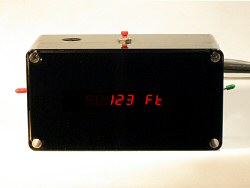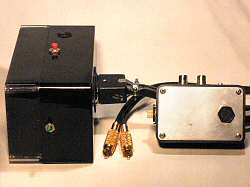LAUGHTON ELECTRONICS |
|
The FM/2: a custom electronic instrument |
|
 |
This article describes a device created in response to a customer request. It is an accessory that connects to an Autologic APS-5 typesetter, and its purpose is to help manage the machine's film supply. |
| APS-5
phototypesetters were used in
the 1980s and 1990s by a
client of mine in Toronto and likewise by an associated American
company. When the US firm added some custom electronics to
their APS-5's my Toronto client asked
me to do
the same for their machine. The purpose of the upgrade was simply to provide the APS-5 with a readout of how many feet of film remained in the machine's film cassette. (This seemingly obvious concern wasn't addressed in the APS-5 design.) A related goal was to have an audible alarm that would alert the machine operator when the remaining film supply fell below a preset threshold. There was initially some discussion about adding a feeler gauge and potentiometer in the film cassette, thus sensing the film roll directly. But the most sensible option was to take advantage of the machine's existing hardware: the APS-5 film mechanism already includes a metering roller and encoder that track the motion of the film. (APS-5 electronics use the encoder signals to coordinate images projected onto the film by a lens and CRT.) My job was to tap in to the encoder signals so the film motion could also be monitored externally by a new device custom built for the purpose. The upper photo is a front view of the FM2; the second also shows the so-called tie-in adapter. This is mainly just a box fitted with an appropriate plug and socket which allow the adapter to be inserted in-line where the encoder attaches to its cable. A pair of RCA jacks connect to coax running to the FM2. This arrangement requires no soldering or permanent connections to the APS-5. (See a subtle real-world consideration, below.) As you may notice, the FM2 has a fairly strong resemblance to a digital alarm clock. Capitalizing on this, the switch functions were specifically organized to be alarm clock-like, making it easy to learn to use the device. The numeric display is switchable to indicate either the present amount of film remaining or the amount at which you want the alarm to sound (analogous to the time & alarm settings on a clock), and these values can be increased or decreased as required. The audible alert — a piezoelectric beeper — sounds through an aperture on top of the device, and the central push button on top is what cancels the alarm signal. (No "snooze" feature, though — sorry!) customer responseThe FM2 was well received by my customer, and of course I was pleased when they acquired a second APS-5 and ordered a second FM2 to go with it. I was even more pleased when the US affiliate ordered FM2's for all their APS-5's. Apparently my device was preferable to what they'd previously obtained.design detailsIn essence the FM2 is just a counter for encoder pulses. There are two pulse trains from the encoder; pulses on one line signify forward motion, and the other line is for reverse. The FM-2 has a divide-by-256 prescale stage; then an MCS-48 Series single-chip microcontroller takes the signals and ultimately scales them into feet. The µC also manages the switches, the alarm and the multiplexed LED display.The unusual styling came about as a result of the need for a window for the LED display. The enclosure is a two-piece plastic box, the front half being transparent polycarbonate that has been almost entirely opaqued on the inside. Click on the lower photo if you'd like a closer look at the construction technique. a subtle real-world considerationBesides being easy to install, there was also good reason for the tie-in adapter to be easy to remove. That's because these typesetters were serviced by Autologic technicians unfamiliar with the FM2, and if they were ever troubleshooting an unknown malfunction they might wonder whether connections to the FM2 were somehow causing interference. Of course I knew that the encoder signals (and their ground return) weren't being degraded, and I could prove it. But explaining or debating the matter would produce delay, contrary to my client's best interests. A better approach was to simply to ensure that the FM2 could easily be disconnected during troubleshooting. |
|
|
|
 |
|


